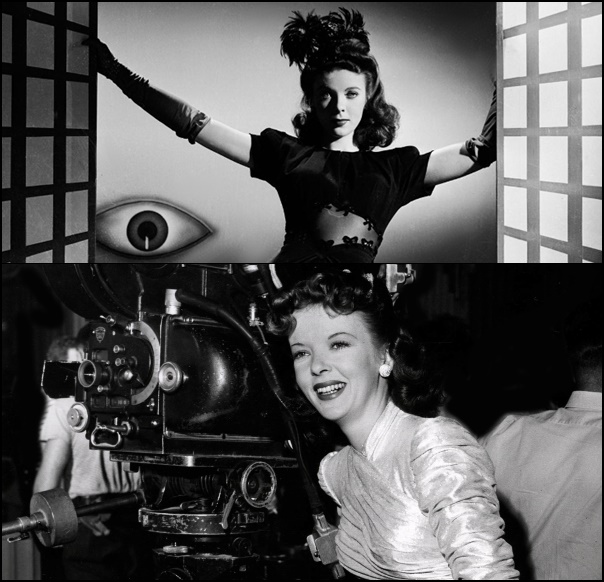In honor of International Women's Day, let's shine a light on the remarkable Ida Lupino!
Born on February 4, 1914,
into a family of actors in showbiz, this London-born actress, producer,
screenwriter, and director made her mark in Hollywood in her teens and
twenties at Warner Bros. Despite a bout with polio in late 1934, her
strength, determination, and talent propelled her to fame with films
such as They Drive By Night (1940), High Sierra (1941), The Sea Wolf
(1941), Ladies in Retirement (1941), and The Hard Way (1943).
 |
They Drive by Night (1940) with Humphrey Bogart
|

 |
Escape Me Never (1947) with Errol Flynn
|
Following a heart attack suffered by director Elmer Clifton while filming Not Wanted (1949), co-writer and co-producer Ida Lupino assumed the directing role without taking any credit. The last female director in Hollywood prior to Lupino was Dorothy Arzner, who retired in 1942. In 1948, Lupino and her then-husband Collier Young formed an independent company, The Filmakers Inc. -developing a series of short, low-budget independent films about taboo, social, and personal topics.During the early days of polio treatment in the U.S., "Never Fear" (1949) portrayed the reality of patients. "Outrage" (1950) examined the negative consequences of rape and victim-blaming. "Hard, Fast and Beautiful" (1951) explored the mother-and-daughter relationship. In "The Hitch-Hiker" (1953), the pathology of the American psycho was examined. "The Bigamist" (1953) dealt with bigamy and pregnancy out of wedlock, while "The Trouble With Angels" (1966) explored the challenges of growing up as a woman under rigid Catholic morality.  |
Co-written by and directed by Lupino- Never Fear (1949)
|
"Ida has more knowledge of camera angles and lenses than any director I've worked with, with the exception of Victor Fleming. She knows how a woman looks on the screen, what light she should have." — cinematographer Archie Stout
Lupino once referred to herself as a "bulldozer" in order to acquire funding for her production firm, yet she referred to herself as "mother" on set. The back of her director's chair was labeled "Mother of Us All" on set.
 |
| Producer-Director Lupino at the center of a parade of her colleagues at her company The Filmakers during production of Hard, Fast and Beautiful (1951) | | |
 |
| Ida Lupino and Robert Ryan in On Dangerous Ground (1951) | | | | |
|

In a male-dominated atmosphere, she made an effort to appear nonthreatening. stating, "That's where being a man makes a great deal of difference. I don't suppose the men particularly care about leaving their wives and children. During the vacation period, the wife can always fly over and be with him. It's difficult for a wife to say to her husband, come sit on the set and watch."
 | | | | | | | |
| Hard, Fast and Beautiful (1951) Directed by Lupino | | | | | | | | | | |
|
|
 |
| Roadhouse (1948) with Richard Widmark |
|
|
 |
| The Bigamist (1953) with Edmond O'Brien directed by Lupino. “I got more satisfaction out of directing than acting. I enjoyed it much more.” | | |
|
|
|
She was acutely conscious of budget considerations, planning scenes in pre-production to avoid technical mistakes and retakes, shooting in public places to avoid set-rental costs, and reusing sets from other studio productions. Lupino had a sharp eye for casting her actors and a knack for instinctively knowing how to light them.

She continued to act while directing a few more films before switching to television. Directing more than 100 TV episodes between 1949 and 1968, among them, Alfred Hitchcock Presents, Daniel Boone, Bewitched, Batman, Charlie’s Angels, The Donna Reed Show, the pilot episode of Gilligan's Island, 77 Sunset Strip, The Rifleman, Have Gun Will Travel (When Clint Eastwood was shooting Rawhide, he would often take a break to watch the filming of Have Gun Will Travel next door. He admired the way she would ride alongside the cameraman to get the perfect action shots), The Untouchables, The Fugitive and one of the top five best episodes of TV's The Twilight Zone- The Masks in 1963. Her last feature film was the Rosalind Russell, Hayley Mills comedy The Trouble with Angels (1966).
.jpg) |
| Director Ida Lupino and Hayley Mills working on The Trouble With Angels (1966) |
Ida Lupino bid goodbye to the film-making business in 1984 and left the Brentwood, California home she shared with soon to be Ex Actor Howard Duff (a frequent co-star) to a smaller residence in Van Nuys. Ida sorrowfully passed away at the age of 77 from a stroke, following her treatments for cancer in Los Angeles, on August 3, 1995.
 |
| "I'd love to see more women working as directors and producers. I want to do pictures of poor, bewildered people. Because that’s what we all are.” | | | | | |
|
Ida Lupino was so much more than a gifted actress - she was an incredible driving force behind classic cinema. Her prowess for the craft enabled her to create an unprecedented, pioneering directing style, blending narrative components and realism to create something captivating. As a woman in the demanding, sexist Hollywood industry, she started out as an actress before to finding her calling as director. A risk-taker and visionary, Lupino responded to difficult commitments with tight time limits and budgets with a fierce tenacity and power continually taking on ambitious, even daring projects others would find hopeless. Despite her limits, she consistently surpassed expectations and deadlines. Let us take a moment on International Woman's Day to revel in the accomplishments of this astonishing filmmaker - she most certainly deserves it!
 |
| “I held my own in the toughest kind of man’s world.” |














.jpg)

No comments:
Post a Comment